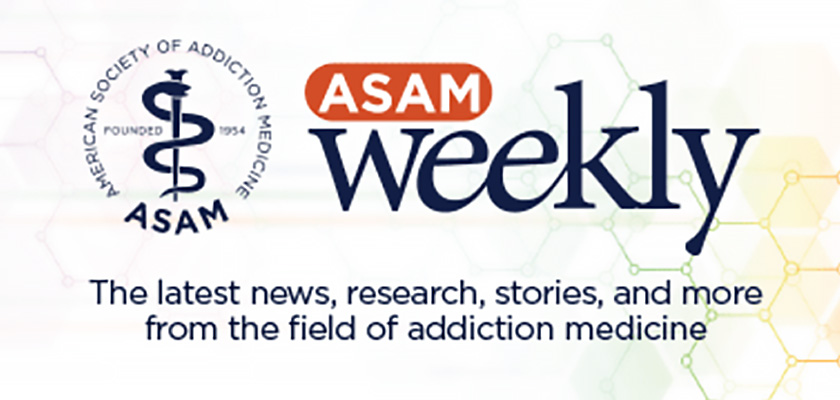News
The ASAM Weekly for October 21st, 2025

This Week in the ASAM Weekly
Gambling Disorder in the Age of Mobile Sports Betting
Nora D. Volkow
Director, National Institute on Drug Abuse
Online gambling is a rapidly growing industry all over the world, affecting both adults and youth. Sports betting is now legal in 38 US states and the District of Columbia, and in 26 states, a person can now make a sports wager on the same device they use to text their therapist or check their social media feeds.
Early data from problem-gambling helplines and state prevalence surveys suggest an increase in both gambling participation and help-seeking, with a disproportionate rise in jurisdictions that permit online betting. This circumstance presents a challenge—and opportunity—for health care in general and addiction treatment in particular. By providing evidence-supported interventions for prevention and treatment, practitioners can help ensure that the rapid growth of mobile betting is matched by an equally rapid, equally sophisticated public-health response.
NEW! The ASAM Handbook of Addiction Medicine, 3rd Edition, is here!
Written for generalists, nurses, physician assistants, and other clinicians, the third edition offers concise, evidence-based guidance for the evaluation and management of substance use disorders. This fully updated edition provides clear, practical coverage of major drug classes, treatment modalities, and medical considerations, with an emphasis on patient-centered care. Each chapter concludes with review questions to reinforce key concepts and support clinical learning.
Lead Story
馃敁&苍产蝉辫;
JAMA Network Open
This meta-analysis that included 13 studies assessed if alcohol consumption per capita is associated with suicide mortality and, if so, does the association differ by sex.鈥疪esearchers found that a 1-L increase in alcohol consumption per capita was associated with a 3.59% increase in the suicide mortality rate. There was no evidence of a sex difference in this association. These findings suggest alcohol consumption per capita may be a useful target to consider within comprehensive national suicide prevention strategies.
Research and Science
馃敁
BMJ Evidence-Based Medicine
Researchers conducted prospective cohort and case-control analyses combined with linear and non-linear Mendelian randomization to investigate the relationship between alcohol consumption and dementia. The findings provide evidence for a relationship between all types of alcohol use and increased dementia risk. While correlational observational data suggested a protective effect of light drinking, this could be in part attributable to reduced drinking seen in early dementia; genetic analyses did not support any protective effect, suggesting any level of alcohol consumption may contribute to dementia risk. Public health strategies that reduce the prevalence of alcohol use disorder could potentially lower the incidence of dementia by up to 16%.
馃敁
BMC Psychiatry
Researchers used data from multiple health databases in Norway to examine the relationship between attention-deficit/hyperactivity disorder (ADHD) and substance use disorders (SUDs). Of 800,187 individuals 6.2% were registered with ADHD and 4.4% were registered with any SUD. Having a diagnosis of ADHD increased the odds of having any SUD over four times (OR 4.2). The strongest associations were for opioids (OR 7.5), stimulants (OR 7.5), and sedatives (OR 7.2). The weakest association was for alcohol (OR 3.6). The authors speculate that the association of ADHD with stimulants could indicate an attempt to self-medicate. They note the presence of a psychiatric disorder further increased the odds of an SUD; this association was strongest with schizophrenia/psychosis. The authors conclude that ADHD (usually diagnosed in childhood) is associated with increased odds of SUDs (usually diagnosed in adults) and suggest that individuals with ADHD receive close follow-up for SUD prevention and early intervention.
Learn More
馃敁
Science Advances
This study sought to quantify chimpanzee consumption of ethanol from fermented fruit. Ethanol concentrations were estimated for ripe fruit samples collected from two chimpanzee habitats in Africa. The amount of fruit consumed and ethanol concentration were then used to determine the average ingested ethanol concentration per body weight. After adjusting for body mass, the amount of ethanol consumed by chimpanzees was equivalent to about 2.6 standard drinks per day for a human. The study suggests that chimpanzee dietary exposure to ethanol is “both chronic and considerable.”
JAMA Psychiatry
This brief report is a cohort study of 1,856 adults in the US that seeks to understand the impact of cannabis legalization on use patterns among people with psychosis. The study data are drawn from the 2014 to 2022 Population Assessment of Tobacco and Health, a nationally representative longitudinal cohort study. Adults with a history of psychosis were included in the study. In states with the legalization of recreational cannabis, study participants significantly increased past-month cannabis use, particularly after retail outlets opened.
AIDS and Behavior
People who use drugs (PWUD) continue to be at high risk for HIV infection, but pre-exposure prophylaxis (PrEP) can prevent infections in this population. Researchers conducted a systematic review to assess interventions for improving adherence to PrEP in PWUD. Most interventions focused on accessibility, including reducing cost, while only a few included behavioral interventions. PrEP integrated with medications for opioid use disorder (MOUD) was highly effective with adherence rates between 80% and 97.6%. Researchers noted women face specific barriers, and trauma-informed services would be beneficial. Overall, the authors note behavioral interventions were underutilized and support additional research on PrEP integrated with mental health services.
In the News
馃敁
Medical Xpress
馃敁
British Broadcasting Corporation (BBC)
馃敁
Healio
The New York Times
馃敁
Carolina Public Press
Los Angeles Times
